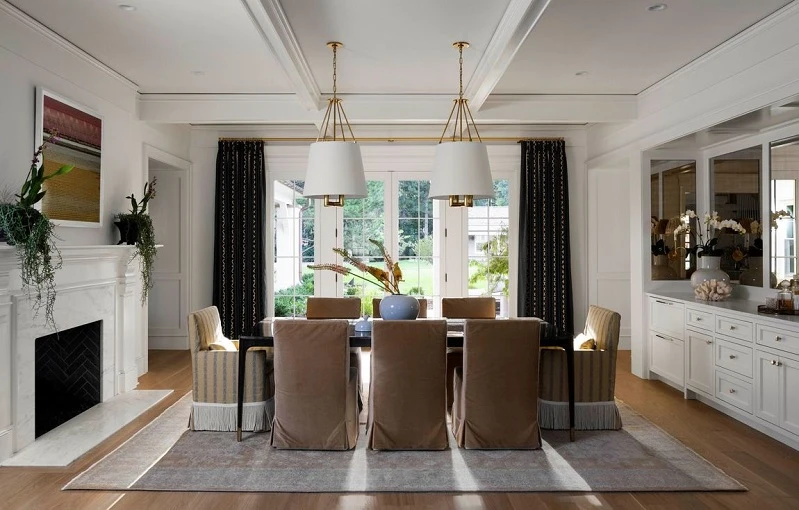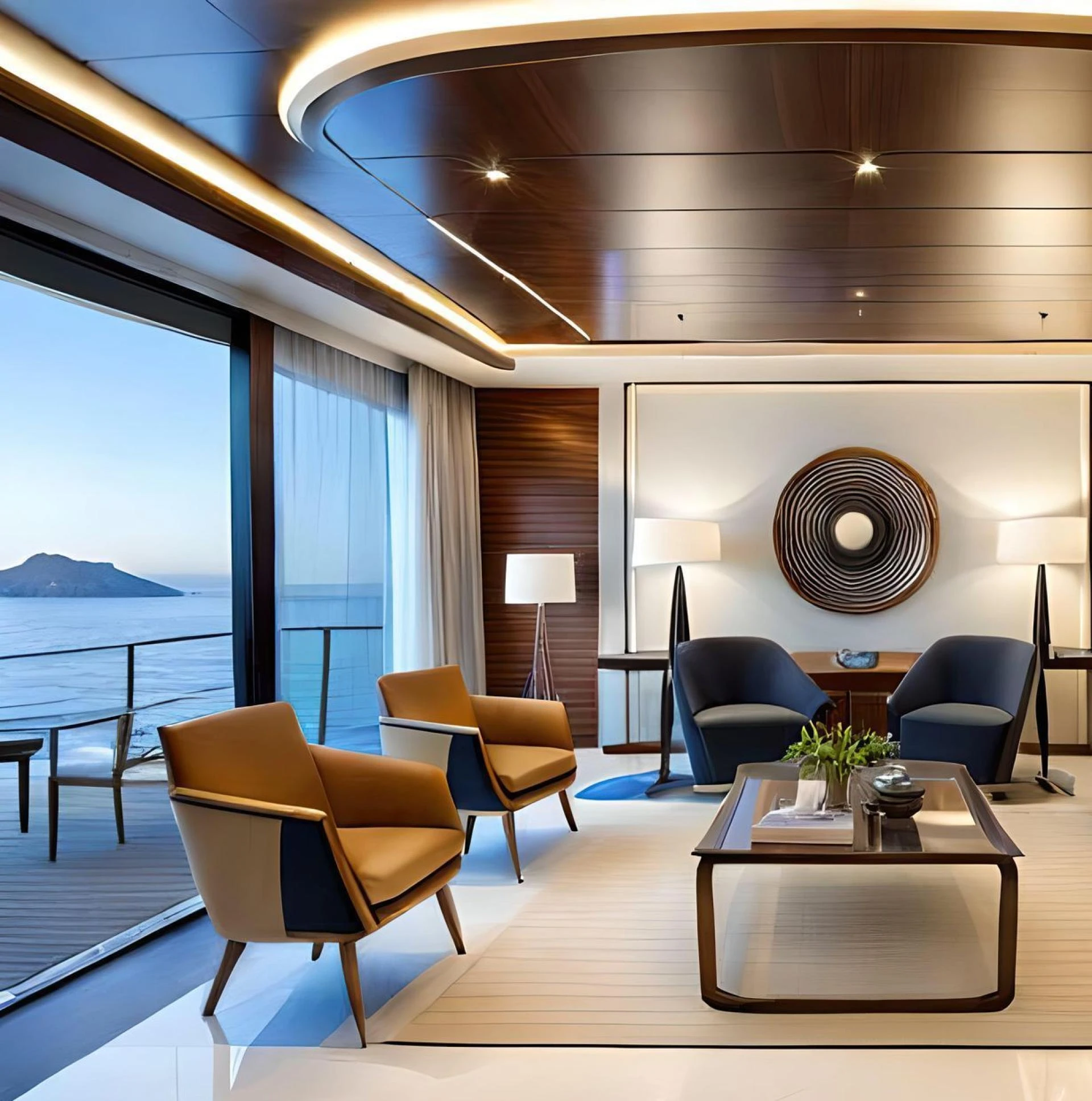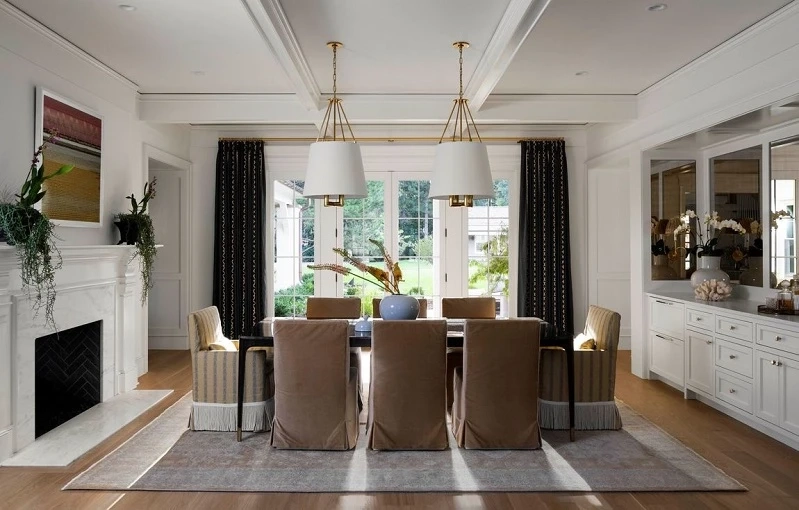Why Yacht Window Treatments Demand Specialist Attention

Climate control and UV protection needs
Yachts encounter harsh environmental conditions that demand more from window treatments than standard installations. Continuous sun exposure, salt-laden air, and temperature fluctuations require materials that are both durable and effective in blocking UV rays. This makes selecting the right fabrics and finishes essential—not just for comfort, but to protect interior furnishings from premature fading.
UV filtering materials can drastically improve energy efficiency on board, maintaining cooler temperatures in cabins and lounges without over-reliance on air conditioning. This is especially valuable in tropical climates, where sustained exposure to heat can quickly affect both wood and fabric finishes.
Space limitations and bespoke fittings
The limited space within a yacht elevates the importance of tailored solutions. Standard-sized window coverings rarely work in marine settings, where portholes and asymmetrical windows are the norm. Even a slight misfit can disrupt a carefully designed interior or impair functionality.
Slimline hardware, precision measurements, and low-profile mechanisms are vital. Treatments must offer smooth operation within tight spaces, particularly when automated controls are involved. Professional fitters familiar with yacht interiors can identify where streamlined or multi-functional options offer the best return on limited real estate.
Balancing luxury with functionality at sea
Aesthetic appeal remains a high priority for yacht owners, but practicality cannot be ignored. Treatments need to align with the yacht’s interior style—whether contemporary, classic, or coastal—while standing up to movement, moisture, and wear.
Achieving this balance requires suppliers who can source high-end finishes with marine-grade performance. Think refined sheers that resist mildew, or timber blinds treated to withstand humidity. The outcome should feel luxurious, yet never compromise safety or ease of use.
Understanding the Materials Best Suited for Marine Environments
Moisture-resistant fabrics and finishes
Marine environments are unforgiving, with humidity and salt air presenting constant challenges. Window treatments on yachts must be made from materials that resist mould, mildew, and moisture damage. Synthetic blends, performance polyesters, and solution-dyed acrylics are commonly used for this reason—they retain their colour and form even after long-term exposure.
In areas where condensation is frequent, such as cabins or bathrooms, waterproof backing or laminated finishes provide additional resilience. These coatings also help maintain shape and structure, preventing sagging or warping over time.
Lightweight alternatives to traditional drapery
Heavy, floor-length drapery is rarely practical on a yacht. Space constraints and constant movement demand lighter, more adaptable materials. Linen-look polyesters, sheer panels, and unlined Roman shades offer a clean aesthetic without adding weight or bulk.
Lightweight options also contribute to safety and storage efficiency. Window dressings that can be easily stowed, adjusted, or removed simplify seasonal use and maintenance. When paired with discreet fittings, they allow the yacht’s architectural features to remain the focal point.
Low-maintenance, high-end aesthetics
While resilience is key, appearance cannot be overlooked. Yacht owners often seek an interior that mirrors residential luxury, just on a smaller scale. Treatments must be easy to clean yet still look refined—this is where performance fabrics with textile-like weaves excel.
Fabrics that mimic silk or linen without the upkeep can elevate a space while standing up to salt spray and direct sunlight. Combining these with sleek, corrosion-resistant hardware—like anodised aluminium or marine-grade stainless steel—ensures the treatment not only performs but enhances the setting.
Types of Window Coverings That Work Best on Yachts
Roller shades with thermal lining
Roller shades are a practical solution for yacht interiors due to their compact form and clean silhouette. When enhanced with thermal lining, they offer superior insulation, reducing heat gain during peak sun exposure. This contributes to energy efficiency and makes temperature regulation easier in enclosed spaces.
Their simple mechanism suits movement-prone environments, reducing the risk of wear and mechanical failure. Available in blackout, translucent, and solar options, they can be tailored to different areas of the yacht—from sunlit lounges to sleeping quarters.
Custom shutters for cabin privacy
Shutters provide a tailored look that suits both modern and traditional yacht interiors. Their adjustable louvers offer excellent control over light and privacy while promoting airflow, which is essential in humid or enclosed areas.
Custom-built to suit portholes or irregular window shapes, shutters lend structure and symmetry to a space. When crafted from marine-grade timber or composite materials, they deliver the richness of wood without susceptibility to warping, cracking, or moisture damage.
Solar shades for light control without sacrificing views
For owners who value uninterrupted views of open water, solar shades present an ideal option. These treatments filter out harsh sunlight while preserving visibility, creating a comfortable yet connected onboard atmosphere.
They are particularly well-suited to salon areas and viewing decks, where maintaining a sense of openness is important. High-performance weaves block glare without darkening the room, and their smooth surface resists grime and salt buildup, reducing cleaning time.
Roman shades for a soft, tailored look
Roman shades bring softness to spaces that often favour hard materials like wood, glass, and metal. Their elegant folds and wide range of fabric options allow for a personalised touch, balancing the yacht’s sleek structure with warmth and comfort.
Despite their decorative appeal, Roman shades remain practical when well-designed. With the right lining and mechanisms, they function reliably even in a rocking vessel. Marine-safe mounting solutions ensure secure installation that lasts through seasonal use and storage transitions.

Why Customisation Is Key for Yacht Interiors
The limitations of off-the-shelf solutions
Off-the-shelf window treatments are designed with standardised dimensions and controlled indoor environments in mind. This presents obvious limitations when applied to a yacht, where every element must be precision-fitted to a non-standard, often mobile space. Portholes, skylights, angled frames, and narrow cabins make uniform products ineffective—leading to gaps, misalignments, and awkward installations that detract from both functionality and design.
The marine setting also demands hardware and fixings that won’t corrode, fabrics that won’t fray under exposure, and control mechanisms that won’t seize from moisture. Off-the-shelf options rarely meet these criteria. Most significantly, they lack the refined finishes expected in high-end interiors, which undermines the experience for owners and guests. A tailored approach, on the other hand, makes full use of available space while matching the visual identity of the yacht.
Working with unusual window shapes and placements
Yacht designers often prioritise architectural style over uniformity. This results in windows placed for maximum light and views rather than standard positioning. It’s not uncommon to find curved windows, tilted skylights, narrow portals in stairwells, or floor-level panes in lounge areas. These features require creative thinking and custom fabrication to manage light, privacy, and usability.
Custom window treatments can be shaped and mounted to suit even the most challenging window structures. Templates, onsite measurements, and digital modelling ensure that fittings are precise, while layered treatments can introduce flexibility in how much light or privacy is needed at different times of day. Where space is tight, designs can integrate flush-fit systems or hidden tracks that preserve clean lines and ensure movement around the vessel remains unhindered.
Integrating automation and smart tech discreetly
Yachts are increasingly equipped with smart systems for lighting, climate control, and security—window treatments are no exception. Automated blinds, curtains, and shades allow owners or crew to adjust interior conditions remotely or by schedule, supporting comfort and energy control with minimal effort. The integration of these systems must be discreet, however, to avoid visual clutter or intrusive cabling that disturbs the yacht’s interior design.
Custom suppliers can embed automation into existing systems, using low-profile motors, hidden tracks, and wireless controls to preserve the elegance of each space. Fabrics and finishes can be selected to match interior furnishings, while control interfaces are often embedded into wall panels or centralised management apps. The result is seamless functionality that feels intuitive, luxurious, and unobtrusive—ideal for a space where design cohesion is essential.
What to Expect from Local Window Treatment Stores
In-person consultations and material sampling
Choosing the right window treatments for a yacht is rarely straightforward, and that’s where the expertise of a reputable local provider becomes invaluable. A well-established local window treatment store will typically begin with a one-to-one consultation, either in-store or on-site. This stage is essential—not only for accurate measurements but also for assessing environmental conditions, identifying window complexities, and discussing functional requirements.
Material sampling is an equally important part of the process. Fabrics must be examined in natural light, tested against the yacht’s interior palette, and evaluated for texture, weight, and resistance. Samples can help clients make informed choices, ensuring that final selections deliver both aesthetic appeal and performance in a marine setting. Reliable providers will also explain the benefits of different mechanisms, coatings, and finishes, so each decision is guided by both form and function.
Measurement, design, and fitting services
Unlike domestic spaces, yachts present a moving, moisture-rich environment where even minor miscalculations can result in significant fitting issues. Accurate measurement is not simply a matter of width and drop; it involves accounting for curvature, movement, ventilation access, and the proximity of furnishings or built-in cabinetry. A specialist will measure with these details in mind, making allowances for flexibility and secure fitting.
Once measurements are confirmed, the design process can move forward with renderings, swatch comparisons, and hardware selection. Many local providers offer CAD visuals or mock-ups to help clients visualise the final result. After production, installation is handled by trained technicians who are familiar with marine standards. This often includes using specialist fixings, non-corrosive materials, and finishes that can withstand temperature and humidity variations. An experienced fitter ensures each element operates smoothly and sits flush with surrounding surfaces, regardless of location on the vessel.
Access to high-end, marine-grade product ranges
Another advantage of working with local window treatment stores is their access to product lines not typically available through online or bulk retailers. Established suppliers can source niche materials designed specifically for marine environments—moisture-repellent fabrics, anti-microbial linings, UV-resistant coatings, and hardware built for longevity in salt air.
More than just offering access to quality materials, these providers understand which combinations deliver both resilience and refinement. They can match specific fabrics with appropriate mechanisms, recommend colourways that complement a yacht’s interior scheme, and propose mounting solutions that maximise space without sacrificing style. This type of tailored guidance is often unavailable through standard vendors or catalogues, and it ensures the final product performs to expectation.
Questions to Ask When Choosing a Local Provider
Do they have experience with marine environments?
Not every window treatment supplier is equipped to manage the demands of yacht interiors. A provider may offer excellent service for residential or commercial settings but fall short when faced with moisture, movement, and limited installation access. It's crucial to confirm whether the company has direct experience working with marine vessels or similar high-moisture, mobile environments.
Those with relevant experience will be able to recommend appropriate materials, anticipate installation challenges, and suggest design solutions specific to yachts. They’re also more likely to be familiar with the necessary safety regulations, mounting requirements, and finishing details that make the difference between a basic fit-out and a lasting, professional result.
Can they accommodate automation systems?
Modern yachts increasingly include centralised control panels or smart home integrations, allowing lighting, audio, and temperature settings to be managed from a single interface. Window treatments should be part of this system, especially on larger vessels where managing multiple blinds manually becomes cumbersome.
When speaking with a provider, it’s worth asking whether they supply motorised options and if these can be integrated with onboard systems. Providers should be able to recommend motor brands compatible with popular marine automation platforms. They should also offer discreet installation options—like recessed tracks or wireless motors—that keep the interior clean and uncluttered. If they offer remote servicing or app-based support, that’s another mark of a forward-thinking business with long-term client value in mind.
What warranties and aftercare do they provide?
Investing in high-quality yacht window treatments means expecting long-term performance. A reputable local store should offer warranties on both products and installation. These might include coverage for fading, moisture damage, hardware malfunction, or installation faults. The length and scope of the warranty often reflect the supplier’s confidence in their materials and methods.
Aftercare services also matter. These can range from seasonal servicing and fabric treatment reapplications, to full removal and reinstallation during renovation or docking periods. Some providers offer on-call support, repair services, or even full treatment replacement in the event of unexpected damage. Choosing a supplier who remains available after installation ensures peace of mind, especially when treatments must withstand such specific environmental conditions.
Tips for Maintaining Yacht Window Treatments
Cleaning methods for salt-exposed fabrics
Salt air deposits can build up quickly on yacht interiors, especially near windows that are regularly opened or located on upper decks. Over time, these deposits can stain fabrics, corrode hardware, or damage coatings if not properly managed. Regular cleaning is key, but methods must be gentle enough to preserve the fabric’s texture and treatments.
Dry brushing or light vacuuming using a soft attachment helps remove surface grit without pulling threads or loosening weaves. For washable fabrics, a damp cloth with mild, non-abrasive detergent is often enough. It’s best to avoid steam or high-pressure cleaning tools, as they can disrupt adhesive finishes or cause fabric warping. Local window treatment stores with marine experience often provide specific care instructions for their products, including guidance on frequency and protective sprays.
How to protect window dressings during storage or docking
When yachts are docked for extended periods or placed in storage, window coverings can suffer from inactivity, exposure, or improper storage conditions. Prolonged sun exposure through uncovered windows may cause fading, while folded or creased treatments stored in humid conditions can develop mildew or lose their shape.
Protective coverings such as breathable fabric sleeves or storage bags help maintain the integrity of removable shades or blinds. If treatments remain installed, it’s worth adjusting them to an open or partially drawn position to prevent permanent creasing. Some owners also opt for UV-blocking films on windows during layups to reduce overall light damage. Consulting the provider during off-season planning helps avoid deterioration and extends the lifespan of the treatments.
Scheduling seasonal checks and professional maintenance
Just as yachts benefit from routine mechanical inspections, window treatments also require occasional servicing. Hinges, cords, motors, and fabric tensions can all degrade subtly over time, especially with frequent use or seasonal exposure. Scheduling maintenance with the original supplier ensures parts are available, records are kept, and consistency is maintained.
Professionals can identify early signs of wear that are not immediately visible—such as weakened tension in spring-loaded blinds or corrosion on interior mountings. For automated systems, periodic software updates or recalibration may be required. A proactive approach not only protects the investment but also avoids disruptive failures during cruising seasons or events.
Blending Aesthetic Consistency Across Yacht Interiors
Colour palettes and texture choices
Design cohesion plays a major role in creating a comfortable and stylish onboard environment. Window treatments should tie in with the yacht’s broader aesthetic, using colour palettes that harmonise with flooring, upholstery, and cabinetry. Light, sea-inspired hues often work well, although darker tones may suit more formal interiors or evening entertaining spaces.
Texture also carries weight in small, contained spaces. Smooth, reflective finishes may give a sense of space, while matte or natural textures provide warmth. Blending tones and textures subtly through window coverings can enhance depth without clutter.
Coordination with existing furnishings and materials
A successful window treatment never exists in isolation. Onboard design often includes built-in furniture, cabinetry, and structural framing—each of which can impact the choice of treatment style, hardware placement, and fabric behaviour. Coordinating finishes across timber blinds, trim lines, or metal tracks helps maintain visual continuity.
Bespoke designs allow for exact colour matching and scaled proportions, ensuring that treatments look intentional rather than added on. It’s especially helpful when trying to mirror shapes, create balance across port and starboard sides, or extend design themes from interior cabins to deck lounges.
How subtle design elevates smaller spaces
Yachts often include small, multifunctional areas that benefit most from subtle, space-enhancing treatments. Sleek blinds, concealed tracks, and neutral palettes can make cabins feel larger and more open. Strategic use of reflective or sheer materials brings in light without sacrificing privacy, which is ideal for shared guest areas.
Rather than dominate a space, good window design works in the background—supporting comfort, framing views, and contributing to a relaxed onboard atmosphere. It’s this level of subtlety, combined with marine-ready performance, that makes yacht window treatment a distinctive design challenge best handled by experienced local providers.


